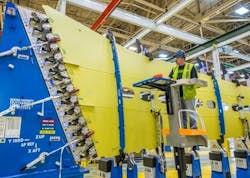Boeing begins production of 737 MAX commercial aircraft
RENTON, Wash., 3 June 2015. Boeing (NYSE:BA) employees in Renton, Wash., have begun building the first 737 MAX single-aisle commercial aircraft on schedule, starting with assembling the wings for the first 737 MAX flight test airplane.
Wings are the first 737 components to be assembled in the Renton production process. Machine operators loaded 737 MAX wing skin panels and stringers into the new panel assembly line that uses automation to drill holes and install fasteners in the upper and lower wing panels. Mechanics also loaded the initial parts of the first 737 MAX spars – internal support structures in wings – into automated spar assembly machines. The unfinished skins, stringers, and spars were machined by Boeing Fabrication Skin and Spar in Auburn and Fredrickson, Wash. When finished, the panels and spars will be transformed into completed wings.
The wings will be attached to the first 737 MAX fuselage on the new Central line in Renton Final Assembly later this year. The new production line will allow the team to isolate the first 737 MAX build from the rest of production in order to learn and perfect the build process while the Renton factory continues to build at a rate of 42 airplanes a month.
“This world-class team is building the future with the first 737 MAX,” says Keith Leverkuhn, vice president and general manager, 737 MAX. “Achieving this milestone on schedule is a testament to the success of the 737 and our integrated design and build team.”
“It’s really exciting to be starting something that you know is going to be in the future and that you are going to be building,” adds David Dowell, 737 mechanic. “I’m looking forward to it and future growth.”
The 737 MAX incorporates the latest technology CFM International LEAP-1B engines, Advanced Technology winglets, and other improvements to deliver high efficiency, reliability, and passenger comfort to the single-aisle market.
Beginning in 2017, the new single-aisle airplane will deliver 20 percent lower fuel use than the first Next-Generation 737s and the lowest operating costs in its class – 8 percent per seat less than its nearest competitor, officials say. To date, the 737 MAX has 2,720 orders from 57 customers worldwide.

Courtney E. Howard | Chief Editor, Intelligent Aerospace
Courtney enjoys writing about all things high-tech in PennWell’s burgeoning Aerospace and Defense Group, which encompasses Intelligent Aerospace and Military & Aerospace Electronics. She’s also a self-proclaimed social-media maven, mil-aero nerd, and avid avionics and space geek. Connect with Courtney at [email protected], @coho on Twitter, on LinkedIn, and on Google+.



